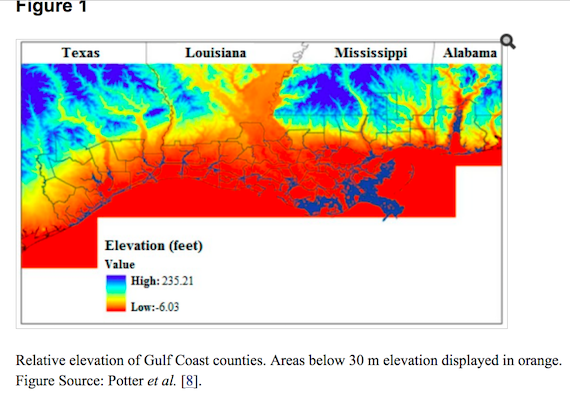Reprint edition
Trump delivered himself of one of the most brain-dead speeches ever given by an American president, more imbecilic even than Bush’s “Mission Accomplished” or Nixon’s “I am not a crook.” He withdrew from the Paris climate accords, saying that he was elected to represent Pittsburgh, not Paris. Trump alleged that he was somehow protecting the United States from dastardly furriners in cancelling the Paris commitment.
Climate change is on a spectrum. We can put up the temperature 3.6 degree Fahrenheit or we can put up the temperature 12 degrees F.
In fact, the US is particularly liable to damage from climate change. Here are the parts of the country he just deeply damaged.
Since Trump made that crack about Pittsburgh, let us begin by considering
1. What Climate Change will do to Pennsylvania:
“Increasing Temperature and Changing Precipitation Rising temperatures and shif ting rainfall patterns are likely to increase the intensity of both floods and droughts. Average annual precipitation in Pennsylvania has increased 5 to 10 per cent in the last century, and precipitation from extremely heavy storms has increased 70 percent in th e Northeast since 1958.”
Trump hasn’t given Pennsylvania more rust belt jobs. He has given it more Johnstown floods.
(The web site cited above is from the old EPA before Big Brother changed History and erased it; it is now hosted at a different server, as though we were a Middle Eastern dictatorship.)
2. The Deep South and the Gulf coast.

In one of those scientific documents that Trump’s Oceania hasn’t managed to erase from the internet yet, the National Institutes of Health says,
“The public health impacts of climate change in U.S. Gulf Coast states—Texas, Louisiana, Mississippi, Alabama, and Florida—may be especially severe and further exacerbated by a range of threats facing the coastline areas, including severe erosion, subsidence, and—given the amount of energy production infrastructure—the ever-present potential for large-scale industrial accidents. The Gulf Coast population is expected to reach over 74 million by 2030 with a growing number of people living along the coastlines. Populations in the region that are already vulnerable because of economic or other disparities may face additional risks to health . . . The Gulf region is expected to experience increased mean temperatures and longer heat waves while freezing events are expected to decrease. Regional average temperatures across the U.S. Southeast region (which includes Arkansas, Tennessee, Kentucky, Virginia, Georgia, North and South Carolina as well as the Gulf Coast) are projected to increase between 4 °F to 8 °F (2.2 °C to 4.4 °C) throughout the century. Hurricanes and sea level rise, occurring independently or in combination with hurricane-induced storm surge, are major threats to the Gulf Coast region [11]. Some portions of the Gulf Coast—particularly coastal Louisiana and South Florida—are especially vulnerable to sea level rise due to their low elevation.”
The Gulf Coast, then, has been sunk by Trump.
3. Carolina coasts:
Another of those government science pages explains what whill happen to the Carolinas:
“coastal homes and infrastructure will flood more often as sea level rises, because storm surges will become higher as well. Rising sea level is likely to increase flood insurance rates, while more frequent storms could increase the deductible for wind damage in homeowner insurance policies. Charleston and the barrier islands are especially vulnerable to the impacts of storms and sea level rise. Changing the climate is also likely to increase inland flooding. Since 1958, the amount of precipitation during heavy rainstorms.”
4. Or consider the impact on Tennessee:.
“more severe droughts and more hot days are likely to reduce [crop] yields, especially in the western half of Tennessee: 70 years from now, that part of the state is likely to have 15 to 30 more days with temperatures above 95°F than it has today. Even on irrigated fields, higher temperatures are likely to reduce yields of corn, and possibly soybeans. Warmer temperatures are also likely to reduce the productivity of dairy and other cattle farms.
Tennessee, in other words, is going to be very hot and produce much less food. So, hot and hungry.
5. And then there is Florida, where rising sea levels will devastate cities and submerge the state over time.
So maybe that should be, there used to be Florida.
——-
Related video:
The New York Times: “Watch Live: Trump on Paris Climate Accord”




 © 2025 All Rights Reserved
© 2025 All Rights Reserved